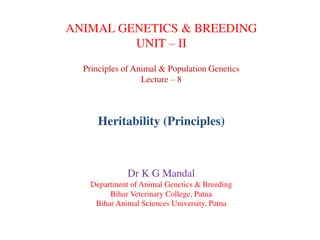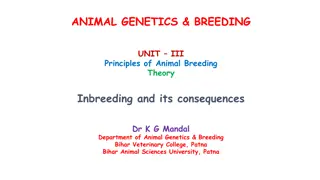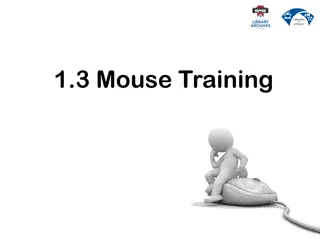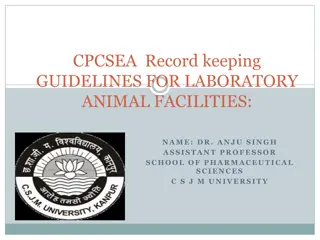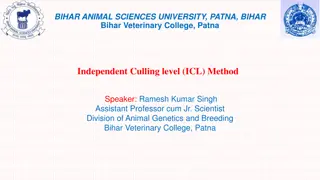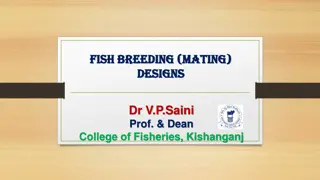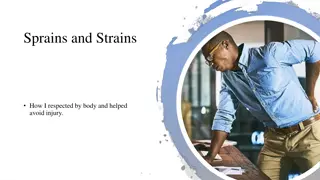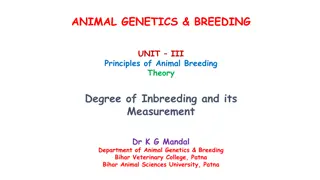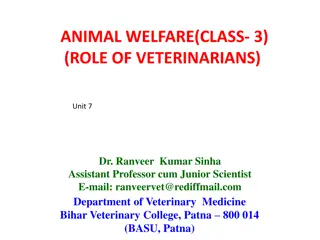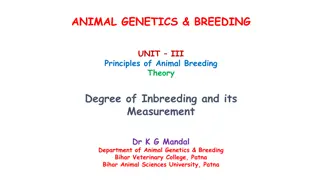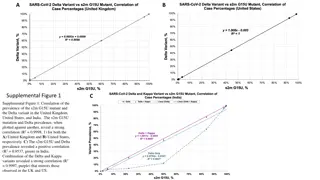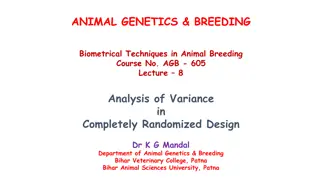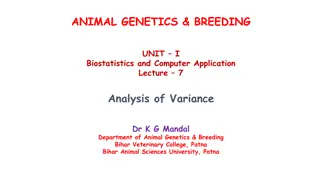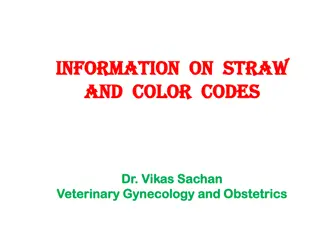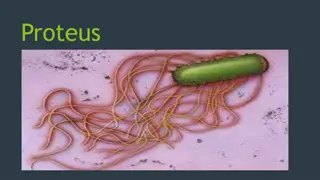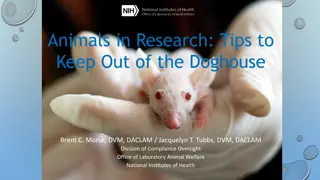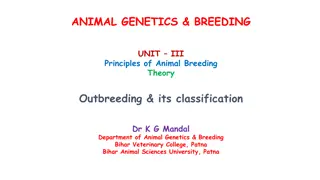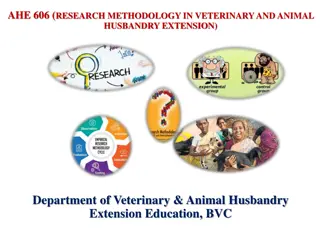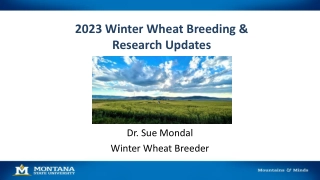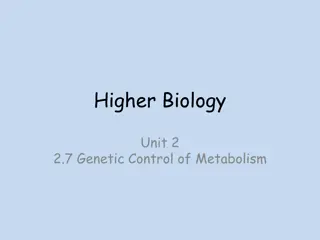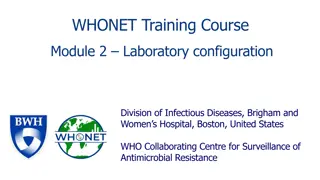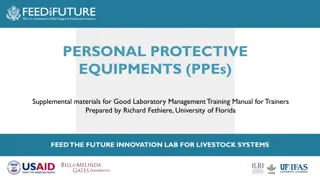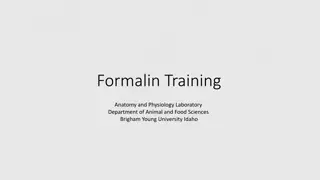Laboratory Animal Breeding and Mutant Mouse Strains in Research
Laboratory Animal Breeding course AGB 610 covers the use of mice in research, highlighting their value, ease of handling, and diverse genetic mutants available. The course explores the popular mouse strains used by immunologists and oncologists, including athymic nude mice and mutants like dh and lpr. Additionally, it discusses the development of inbred strains and the importance of congenic mouse strains in research.
Download Presentation

Please find below an Image/Link to download the presentation.
The content on the website is provided AS IS for your information and personal use only. It may not be sold, licensed, or shared on other websites without obtaining consent from the author. Download presentation by click this link. If you encounter any issues during the download, it is possible that the publisher has removed the file from their server.
E N D
Presentation Transcript
Couse number AGB 610 Couse number AGB 610 Course Title: Laboratory Animal Breeding Course Title: Laboratory Animal Breeding Common Laboratory Common Laboratory animal and Breeding Colonies animal and Breeding Colonies Instructor: Dr Instructor: Dr Shanker Univ. Professor, AGB Univ. Professor, AGB ShankerDayal Dayal
Laboratory animals Laboratory animals Species Used In Research Species Used In Research Mice Mice Scientific Name: Scientific Name: Mus musculus small small and and prolific prolific and and most most economical easy easy to to handle handle and and have have a a very be be used used for for restraint restraint and and collection most most widely widely used used laboratory laboratory species 50 50% % of of animal animal use use widely widely used used by by immunologists, immunologists, oncologists wide wide range range of of genetically genetically defined mutants mutants are are available available economical amongst very convenient convenient tail collection of of blood species accounting amongst lab tail which blood accounting for lab animal animal which can can for over over oncologists and defined inbred and geneticists geneticists inbred stains stains and and
Several Several mutants are are of of great great value athymic athymic nude responses responses and xenografts xenografts of of human Other Other popular popular mutants dominant dominant hemirnelia hemirnelia (Dh, proliferation proliferation ( (lpr More More than than 350 350 different though though most most research common common strains strains. . more more popular popular mouse CBA/Ca, CBA/Ca, C C3 3H/He, H/He, DBA/ mutants strains value in in research nude mutation mutation have and can can be human origin mutants strains been developed, developed, some eg. . animals animals homozygous have no no cell cell- -mediated be used used to to grow grow tissue origin. . strains include include obese obese ( (ob (Dh, which which is is also also asplenic lpr) ) which which causes causes autoimmune autoimmune disease different inbred inbred strains strains of of mice research is is conducted conducted on strains have research. . eg have been some of of which homozygous for mediated immune tissue and and tumour which for the the immune tumour ob), ), diabetic diabetic ( (db asplenic) ) and disease. . mice are are available, on about about 10 10- -12 12 of of the db), ), and lymph lymph available, the most most mouse strains DBA/2 2, , SJL strains are SJL and are BALB/c, BALB/c, C C57 and SWR SWR. . 57BL/ BL/6 6, , C C57 57BL/ BL/10 10, ,
A large number of congenic mouse strains, produced by A large number of congenic mouse strains, produced by backcrossing a gene to an inbred background (the inbred backcrossing a gene to an inbred background (the inbred partner strain) have also been developed. Such strains are partner strain) have also been developed. Such strains are essential for work involving the study of immune responses essential for work involving the study of immune responses to parasites, viruses and bacteria, as well as chemical to parasites, viruses and bacteria, as well as chemical antigens. antigens. Congenic mice Congenic mice An inbred strain of An inbred strain of mouse small genetic material (preferably single gene) from small genetic material (preferably single gene) from another strain but otherwise identical to the original another strain but otherwise identical to the original inbred strain. inbred strain. mouse that contains a that contains a Mice are not suitable for experiment requiring Mice are not suitable for experiment requiring experimental surgery due to its small size experimental surgery due to its small size
Rat Rat Scientific Scientific Name Rats Rats are are prolific conditions conditions. . Rats Rats weight weight about particularly particularly suitable quantities quantities of of tissue, difficult difficult in in an an animal Rate Rate are are generally generally preferred pharmacologists pharmacologists because because because they they do do not as as mice mice. . Name Rattus norvegicus prolific and and are are well well suited suited to to laboratory laboratory about ten suitable for tissue, or or surgical animal as as small preferred over because of of their not have have so ten times times as as much for research research which surgical techniques small as as the the mouse over mice their convenient so many many virally much as as mice, which requires techniques which mouse mice by by toxicologists toxicologists and convenient size, virally- -induced induced tumours mice, so so they requires larger which are they are larger are are and and size, and tumours
Syrian Hamster Syrian Hamster Scientific Name Scientific Name Mesocricetus auratus intermediate intermediate in in size reasonably reasonably prolific, for for the the rat, rat, so approximately approximately the they they are are the the only induced induced to to hibernate immunologically immunologically privileged some some tumour tumour xenografts to to assess assess the the fertilizing size between between mice prolific, and and do so the the cost cost of of breeding the same same as as for only common common laboratory hibernate have have a a cheek privileged site xenografts and fertilizing capability capability of of human mice and well in in cages breeding and for the the rat laboratory species cheek pouch site and and can and the the hamster hamster egg human semen and rats cages which and maintaining maintaining them rat species which pouch which can be be used used to to grow egg can semen. . rats which are do well are suitable suitable them is is which can which is is an can be be an grow used can be be used
Guinea Guinea- -pigs pigs Scientific Name Cavia porcellus They They have the the rat), rat), and but but the the young eyes eyes. . have a a long and a a small young are long gestation gestation period small litter litter size are quite quite mature period (about size (about (about 4 4 young mature at at birth (about 65 young compared birth with with a a good 65 days days compared compared with compared with good coat with 21 10- -12 12 in in the coat of of hair hair and 21 days days in in the rat), and open open with 10 rat), They They require require dietary dietary source source of of vitamin vitamin C C. . There There are 13 13. . are a a few few established established inbred inbred strains strains of of guinea guinea- -pigs pigs such such as as strains strains 2 2 and and most most commonly commonly used biological biological fluids fluids and (e (e. . g g. . vas vas deferens deferens or or gut) used as as a a source and tissues tissues in in immunological immunological assays, gut) in in pharmacological pharmacological studies source of of complement complement ( (i i. . e e. . serum) assays, and studies. . serum) and source of of tissue and other other tissue and as as a a source
Rabbits Scientific name Scientific name Oryctolagus cuniculus Prolific Prolific ovulation ovulation induced induced by by mating Short Short gestation gestation period period ( (31 widely widely used used in in reproductive teratogenicity teratogenicity investigations investigations as as it it is is the species species producing producing malformations malformations on thalidomide thalidomide. . Teratogenicity Teratogenicity Capability Capability of of producing widely widely used used for for the the production production of of antisera convenient convenient size size mating 31- -33 reproductive studies, 33 days) days) studies, particularly particularly in in the only only common on treatment treatment with common with producing foetal foetal malformation malformation antisera as as they they are are a a
used used routinely routinely for presence presence of of pyrogenes for testing testing pharmaceutical pharmaceutical preparations pyrogenes. . preparations for for the the Other Other species species Fish Fish are are widely chemicals chemicals and Amphibian Amphibian are for for teaching teaching Dogs Dogs are are widely surgery surgery Cats Cats are are commonly commonly used to to study study short short- -term Many Many species species of of primates which which require require animals possible possible. . widely used and industrial industrial waste are used used for used for for toxicological toxicological studies waste waters waters. . for studying studying development, development, physiology, studies of of e e. . g g. . agro agro- - physiology, and and widely used used in in toxicology toxicology and and for for experimental experimental used by drug and primates are animals which by pharmacologists pharmacologists and and hormone hormone responses are used used in in a a wide which resemble resemble man and physiologists physiologists responses wide variety variety of of studies man as as closely term drug studies closely as as
Recommended Room Temperatures and Relative Humidity for Adult Laboratory Animals Animal Animal Temperature (oC) Temperature (oC) 18-26 18-26 18-26 20-22 17-25 16-21 18-29 16-27 22-26 18-26 Humidity (%) Humidity (%) 40-70 40-70 40-70 30-50 40-70 40-60 30-70 30-70 Mouse Mouse Rat Rat Hamster Hamster (Syrian) Gerbil Gerbil (Mongolian) (Mongolian) Guinea Guinea Pig Pig Rabbit Rabbit Cat Cat Dog Dog Pig Pig Chicken Chicken Nonhuman Nonhuman Primate - -New New World World & & Prosimians (Howler (Howler monkey) monkey) - -Old Old World World Macaques) Macaques) (Syrian) 45-70 Primate: : Prosimians - 60-65 (Baboon, (Baboon, - 45-60
Breeding data for some common laboratory species Breeding data for some common laboratory species Character Character Typical adult weight (g) Typical adult weight (g) Average longevity (years) Average longevity (years) 1 1- -2 2 Age at puberty (days) Age at puberty (days) Usual breeding age (days) Usual breeding age (days) 50 Mating system Mating system Length of oestrus cycle (d) Length of oestrus cycle (d) 4 4- -5 5 Ovulation Ovulation Gestation period (days) Gestation period (days) Average litter size Average litter size Weight at birth (g) Weight at birth (g) Weight at weaning (g) Weight at weaning (g) Age at weaning (days) Age at weaning (days) Productivity (young per Productivity (young per Breeding unit per year*) Breeding unit per year*) M Monogamous pair C Colony D- Hand mating H- Harem mating S- Spontaneous I- Induced Mouse Mouse 25 25- -30 30 Hamster Hamster 150 150 2 2- -3 3 45 45- -60 60 56 56 D,M D,M 4 4 S S 16 16 4 4- -8 8 1 1- -2 2 21 21 25 25- -50 50 Rat Rat 250 250- -400 500 400 500- -800 2 2- -3 3 45 45- -75 75 80 80 M,H M,H 4 4- -5 5 S S 21 21- -23 23 6 6- -12 12 5 5- -6 6 35 35- -40 40 21 21 25 25- -100 100 Guinea Guinea- -pig pig 800 1000 4 4- -8 8 45 45- -75 75 80 80 C C 14 14- -16 16 S S 65 65- -72 72 3 3- -4 4 85 85- -90 90 - -250 250 14 14- -21 21 12 12- -18 18 Rabbit Rabbit 1000- -7000 5 5- -6 6 150 150- -210 210 150 150- -210 210 D D n.a n.a. . I I 32 32- -32 32 6 6- -8 8 - -100 100 - -1000 1000 50 50 15 15- -20 20 7000 35 35 50 M,C M,C S S 20 20 6 6- -10 10 1 1- -2 2 10 10- -12 19 19- -21 25 25- -75 12 21 75
Mice Mice Breeding Breeding colony colony Life Life span span 2 2. .5 5 years years; ; however, however, reproductive reproductive life life span span 7 7- -8 8 months months. . sexual sexual maturity maturity (males (males and and females) females) at at 4 4- -7 7 weeks weeks of of age age. . Younger Younger mice mated mated until mice generally generally produce until they they reach reach 6 6- -8 8 weeks, produce smaller weeks, of of age smaller litters age. . litters and and therefore therefore are are not not typically typically Mice Mice that successfully successfully if if they that have have been they are been housed housed alone are older older than alone or or in in same than 6 6- -8 8 months months. . same- -sex sex pairs pairs will will usually usually not not breed breed Estrous Estrous cycle cycle 4 4- -5 5 days days in in length length. . Mice Mice cycle mice mice are cycle continuously continuously throughout are only only receptive receptive to to males throughout the males when the year year (non when they they are (non- -seasonal seasonal breeders) are in in estrus estrus. . breeders). . Female Female Mating Mating typically typically occurs occurs at at night night (Light (Light off) off) Ovulation Ovulation occurs occurs 8 8- -10 10 hrs hrs after after the the onset onset of of estrous estrous. . If If fertilization fertilization occurs, occurs, fetuses fetuses can can be be palpated palpated by by day day 14 14. .
Gestation in mice is typically 19 Gestation in mice is typically 19- -21 days (strain dependent). 21 days (strain dependent). Parturition may last 1 Parturition may last 1- -3 hours and frequently occurs at night. 3 hours and frequently occurs at night. Females will go into Females will go into estrus receptive during this time. receptive during this time. estrus within 24 hours of parturition and are sexually within 24 hours of parturition and are sexually Litter size varies among strains, but averages 4 Litter size varies among strains, but averages 4- -12 pups. Inbred mice tend to have smaller litters than outbred mice. have smaller litters than outbred mice. 12 pups. Inbred mice tend to Mice are typically weaned at 21 Mice are typically weaned at 21- -28 days 28 days pr pr at 10 gm body weight at 10 gm body weight Factor effecting reproduction Factor effecting reproduction Strain Strain Age Age Environment Environment Diet Diet High Fat 11% vs 4% in some strain High Fat 11% vs 4% in some strain Health Health Pheromones Pheromones
Lee Lee- -Boot Boot Effect result in the suppression of estrus This phenomenon in combination with the Whitten effect, is used to synchronize estrus in female Effect: : Housing female mice in close density in isolation from male mice will Whitten Whitten Effect previously suppressed females within three days. Effect: : Male mouse urine contains a pheromone that induces estrus in Bruce Bruce effect terminate their pregnancies during the preimplantation period, following exposure to the scent of an unfamiliar male. During the first 5 days of pregnancy, females should not be exposed to foreign males or their soiled bedding effect (Pregnancy (Pregnancy block) block):This is the phenomenon by which female mice
Rat Rat Breeding Breeding colony Generally, Generally, male male laboratory weeks weeks of of age, age, although age age. . The The reproductive reproductive lifespan The The duration duration of of the characteristic characteristic phases estrous estrous cycle cycle can can be Rats Rats are are polyestrous polyestrous and ovulation ovulation is is spontaneous spontaneous. . Mating Mating is is usually usually nocturnal Gestation Gestation period period: : 21 Weaning Weaning age age: : 21 Pregnancy Pregnancy may may be A A fertile fertile postpartum postpartum estrus time time are are better better than Failure Failure to to conceive conceive at at that litter litter is is weaned weaned. . colony laboratory rats although females rats will females may will reach reach sexual may have have their sexual maturity maturity at at approximately their first first estrus estrus as as early approximately 10 early as as 8 8- -9 9 weeks 10- -12 12 weeks of of lifespan of of rats the estrous estrous cycle phases: : proestrus proestrus, , estrus be determined determined by and breed breed year rats is is on cycle is is 4 4 5 5 days estrus, , metestrus by vaginal vaginal cytology year round round on average average between between 12 days. . The metestrus and cytology. . 12 and and 15 The cycle cycle is is divided and diestrus diestrus. . The 15 months months. . divided into The stage into four stage of of the four the nocturnal. . 21- -23 23 days 21- -23 23 days days be confirmed confirmed by estrus occurs than 50 50% % successful that time days by gentle gentle abdominal abdominal palpation occurs within within 48 48 hours successful. . time will will delay delay breeding palpation after hours of of giving giving birth after gestation gestation day birth and and mating day mating at at that that breeding until until two two to to four four days days after after the the
Breeding Breeding cages females, females, and The The maintenance maintenance of of good Breed Breed the the female female is is at at least depending depending on on strain strain. . Young Young males males should should not 275 275- -350 350g g. . Breeding Breeding stock stock is is replaced Before Before their their reproductive reproductive performance decreases decreases if if the the rats rats are If If no no litters litters have have been been born strain strain is is known known to to have have low If If several several litters litters have have been If If a a significant significant decrease decrease in in litter Do Do not not replace replace all all breeding breeding breeding animals animals of of various cages should should be and a a check check of of the be observed observed daily the animals animals health good breeding breeding records least 90 daily for health and records is is essential 90 days days old old and for new new born, and general general condition essential. . and approximately approximately 200 born, weaning, weaning, separating condition. . separating of of 200- -275 275g, g, not be be used used until until at at least least three three months months of of age age or or weigh weigh replaced performance begins are older older than than 9 9 months born in in 2 2 months low fertility) fertility) been born born but but no litter size size is is noted breeding animals animals at at the various ages ages in in the begins to to decline months old old. . months and and female decline. . Breeding Breeding success success female is is not not pregnant pregnant (unless (unless no pups pups have noted have been been weaned weaned. . the same same time the colony colony. . time. . It It is is best best to to have have




